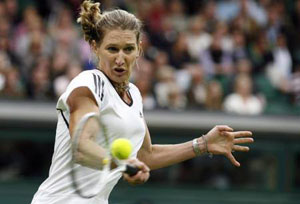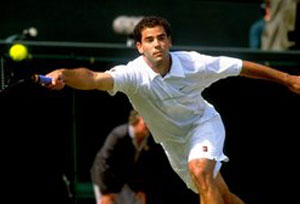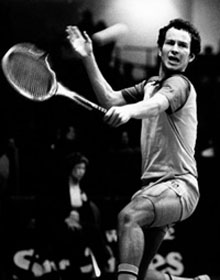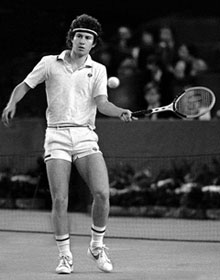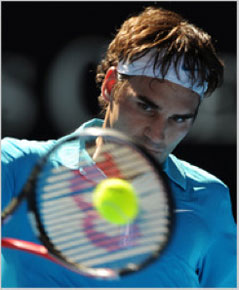|
TennisOne Lessons Contact In Front and Tracking the Ball Daryl Fisher When you play tennis, do you have trouble “watching the ball?” Many people do, but you might be pleased to know that your ability to see the ball clearly can be improved, and not just by concentrating or focusing better. It can be improved by meeting the ball more in front.
If you read my last article on the topic of contacting a tennis ball in front, then you already know how to locate “in front” and that to meet the ball in front can change your game for the better through stable alignment. While the value of stable alignment cannot be understated, more people intuitively understand the value of visually tracking the ball (more commonly known as “watching the ball”). What is less understood is that there is a connection between meeting the ball in front and visually tracking the ball. In fact, especially as ball speeds increase, the difficult and important task of visually tracking the ball can be made significantly easier by meeting the ball farther in front. This helps to explain why Rafael Nadal meets the ball so far in front with his two-handed backhand when he could achieve more lateral reach if he met the ball more next to him. Given his arm strength and the fact that he has two hands on the racquet, stable alignment is definitely not why he has a clear preference for meeting the ball so far forward. To meet the ball in front makes tracking the ball easier, and, in some cases, possible. Tennis Fans Demonstrate If you are a tennis fan, you have perhaps seen a crowd of people watch a tennis match. If so, you might also have noticed that the people watching the tennis match while sitting to the side of the court (near the net post) get a neck workout. As the tennis ball goes back and forth across the net, people sitting to the side of the court naturally move their heads back and forth keeping the ball in front of their faces. In contrast, the people sitting behind the baseline at one end of the court or the other barely move their heads at all. The ball is always in front of them, and so they do not need to move their heads in order to track the ball. Keep Your Head Still The same head movement is true when you are on the court playing, with the important difference that when you are playing you are much closer to the action. If you keep the ball more in front of you, you will need to move your head less. If you let the ball get more next to you, alternatively, then it is highly likely that you will attempt to turn your head very quickly in order to try keep the ball within your visual focus.
High-speed photography and video shows that most current professionals also move their heads, but just slightly, as the ball nears them. Despite this head movement that is often barely perceptible to the naked eye, the tennis pro admonition to “keep your head still” remains generally true. Excessive head motion can throw off your balance, and while a small amount of head motion can be acceptable, you do not want to have to move your head much. Perhaps more importantly, at certain ball speeds your head movement cannot keep up as the ball begins to pass from in front of you to next to you, and as a result the ball will either pass out of your visual focus or you might even completely lose sight of the ball. Photographs As you consider the possibility of seeing a fast moving object as it moves next to you, start looking at photographs of professional players as they hit ground strokes and volleys. Notice that if the contact point is well in front, then the player’s eyes are generally directed toward the ball. Alternatively, if the player is on the full stretch to reach a ball and making an emergency shot with the contact point more next to the body, notice that the face and eyes are often still directed forward toward the opponent and not toward the ball. This observation is no fluke; unless the ball is moving sufficiently slowly, it is very difficult to move the head fast enough to maintain sight of the ball. Even pros have limitations with regard to being able to see the ball when it is next to them.
Speed LimitsAs your opponent strikes the ball, of course you can see it, and as long as the ball is in front of you, you will continue to be able to see it. As you should understand now, there is a point at which your eyes and/or whole head would have to shift considerably in order to continue to see the ball when it is more next to you. If the ball is moving very slowly, that might not be a problem, but the challenge increases as the speed of the oncoming ball increases. Of course pro tennis players must deal with fast-moving tennis balls regularly, but even many amateur matches are won and lost because of a limitation on being able to handle certain ball speeds. No matter how quickly you can turn your head, there exists a ball speed at which you can no longer turn your head quickly enough to keep the ball in your visual focus. Perhaps your eyes could move so as to be able to track the ball, but when the ball is next to you, you would need to be looking out of the corners of your eyes, which would be uncomfortable. Bottom line, it is better to keep the ball in front so that you do not have to concern yourself with seeing the ball out of the corner of your eyes or with moving your head.
Calculating Minds One interesting aspect of tracking a tennis ball is that with practice our minds can become very good at making the calculation of where a ball will go based on its current trajectory so we do not actually always need to see the ball all the way to the racquet with perfect hawk-like attention. It is amazing that, in many cases, when pros are not looking at the ball at contact they are still likely to hit a fairly decent shot. While we can all benefit from this ability occasionally, it might also be best used only occasionally. Our ability to consistently generate power with accuracy depends in a subtle and important way on how regularly we can get a ball to land in a good place on our racquet’s string bed, so the better we track the ball, the greater our likelihood of having the ball land in a desirable place on the string bed, which in turn leads to a greater likelihood of hitting the shot that we want. There is a significant difference between a shot that hits the sweet spot and a shot that lands only 3 inches in any direction from the sweet spot. So, even for those that are “good” at making decent contact without visually tracking the ball to the strings, most of us most of the time are more likely to hit a shot that we like if we track the ball more carefully.
John McEnroe is a good example of someone with a game and a mind made for making good use of the ability to calculate where a ball will go. His ability is truly amazing, and it makes it possible for him to regularly know where the ball is in relation to his racquet without watching the ball right up to contact. A number of factors contribute to his ability to do this. One factor is the grips that he uses. They are classic Continental with the exception of his forehand groundstroke, which is half way between an Eastern forehand and a Continental. These grips make meeting the ball fully in front somewhat awkward, so even if he wanted to meet the ball farther in front, it would be anatomically difficult. Another factor that seems crucial involves his generally compact motions and short backswings. If he used longer, quicker, or whippier swings he would almost certainly need to track the ball with greater accuracy. Roger Federer's grips, in contrast to McEnroe’s, are certainly more conducive to meeting the ball farther in front for his topspin shots. For Federer's topspin strokes, he generally meets the ball farther in front than McEnroe. This is partly for the benefit of stability and partly for the benefit of tracking the ball. I would not go so far as to call Federer’s strokes long or whippy, but they are longer than McEnroe's, and definitely capable of generating and handling more pace. Also in contrast to McEnroe, I have yet to see a photo of Federer in which he is not looking at the ball unless he is looking at the space where he had just hit the ball (see videos above). For most of us, tracking the ball with greater attention like Federer means more to our success. So, if you are not quite at McEnroe's level in terms of being able to calculate where the ball will go, for the sake of being able to handle and generate more power, and for being able to track the ball better, you would likely be better off meeting the ball farther in front of you like Federer. Bonus As an added bonus for meeting the ball farther in front, you get to know more about what your opponent is doing as you simultaneously track the ball to your racquet. This is because both the ball and your opponent are within closer proximity to each other within your field of vision. That is, if you hit the ball more next to you, the focus of your attention is likely shifted more to the side, putting your opponent more in the periphery of your vision, but even worse, the focus of your attention could be more on your opponent, putting the ball more in the periphery of your vision. I have heard the observation that Federer often looks as if he is looking at the ball through his strings at contact on his ground strokes and volleys, and while I doubt this because of the speed at which that would need to happen, his racquet is sufficiently forward to make it possible. Regardless of whether Federer looks through his strings to see the ball at contact, however, what is true is that his opponent is only slightly away in his field of vision from the visual focus of his attention, the ball. In this way he can watch the ball and have a good idea of where his opponent is with no extra effort or shifting of attention. Alternatively, if McEnroe wants to know where his opponent is, he is going to have to be looking in a different direction than where he is making contact with the ball (which he does remarkably well).
Experiment As a way of testing what I have said about meeting the ball in front, try the following experiment. In a car, watch the street signs. Only do this as a passenger and not as a driver, by the way, so as not to endanger yourself or anyone else. Look at a street sign while the street sign is in front of the car, and then try to see the street sign as the car passes by. You will notice that it is fairly easy to see the street sign while it is in front of the car, but, especially as the car goes faster, the sign is quickly lost from sight as the car nears being next to the sign. Of course the speed of the car makes some difference, and a very slow-moving car will make it possible for you to turn your head quickly enough to see the street sign, but surprisingly low speeds will still make it difficult. For most people, watching the sign is very difficult even with the car moving at only 35 mph, and tennis ball speeds for most tennis players have a regular chance of exceeding 35 mph. Summary While it is possible to be a good tennis player while meeting the ball next you and not seeing the ball near contact with your racquet, as McEnroe demonstrates, it is likely that your strokes and overall ability to track a ball are not quite like McEnroe's. No matter your ability, it is likely that you will benefit from meeting the ball farther in front. Meeting the ball in front will help you be more stable, thereby making you better able to handle and generate power, and the ability to track the ball closer to your contact point can only help you make better contact. Do not forget the bonus: you will be able to track the ball while keeping better track of your opponent as well.
Your comments are welcome. Let us know what you think about Daryl Fisher's article by emailing us here at TennisOne. |
||||||||||

